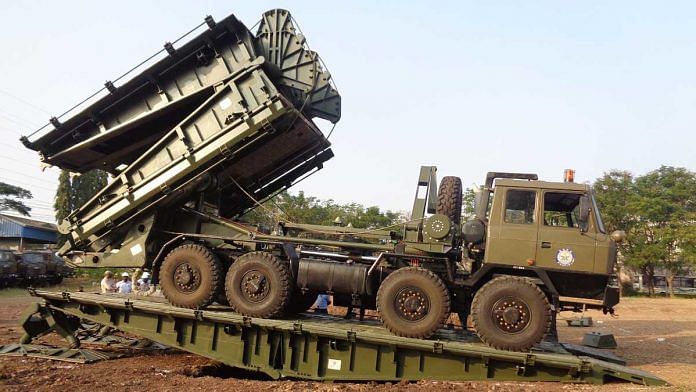New Delhi: Aside from acquiring new arms, the Army is also quietly bringing in massive changes to its ‘move’ capabilities against both China and Pakistan by working on the latest assault bridging systems. These bridging systems are being indigenously built.
Leading the charge is a collaborative effort by the Army’s Corps of Engineers, the Defence Research and Development Organisation (DRDO) and Larsen and Toubro (L&T), a private firm.
On Friday, the Army inducted the first twelve 10-metre short span bridging systems that will be deployed in the western borders shared with Pakistan by combat engineers. According to DRDO chief Dr G. Satheesh Reddy, L&T will deliver 30 more bridges by August.
The Rs 492-crore contract for a total of 110 such systems was signed last year and the delivery is set to be completed by 2023.
This system will be used to bridge gaps of up to 9.5 metre with a single span (slab supported on both ends), which is four-metre-wide with a fully decked roadway, over water bodies and canals so that tanks, armoured vehicles and troops can easily move across while operating against Pakistan.
“The induction will increase the capability of the Indian army. We had a five-metre and 15-metre span bridge but 10 metres was always needed. This will fulfil the gap and will enhance the mechanised formation’s capability and operation speed in the western front,” said Army chief General M.M. Naravane, at the induction event of the bridging systems at Delhi Cantonment.
These bridging systems are also compatible with the Sarvatra Bridging System that is 75-metre-long, where the last span requires covering gaps less than 9.5 metre.
Also read: Drones pose new challenge, more state and non-state actors will use them: Army chief Naravane
Arjun tank can cross canals and water bodies via bridges
Capable of withstanding a weight of up to 70 tonnes, the 10 short span bridging systems replace the existing AM 50 assault bridge, which had been imported from Czech Republic and could only handle 50 tonnes.
As a result, the new systems mean that the 68-tonne Arjun Main Battle Tank can also move with ease on the bridges for cross-border operations.
According to sources, despite the Covid pandemic and the related lockdown, the company has delivered ahead of the contracted schedule.
They further noted that the 10-metre short span bridging system can be deployed in 10 minutes by a team of four personnel and a driver. It is compatible with existing bridging systems that enhances the flexibility to cover all types of water bodies.
With the latest induction, the Army has short span bridging systems for gaps of 5 metres, 10 metres and 15 metres. The induction of the 5 and 15-metre bridging systems started in 2017 and both have also been manufactured by L&T.
Sources noted that L&T has also developed new systems with composites that make it much lighter.
“L&T has also developed a bridging system made of composites which remains lighter and equally strong. This helps in faster deployment,” a source said.
New foot bridges for mountains
“The Army has been focusing on bridging capabilities. Our stress has been on metallurgy so that the system becomes lighter and easier to operate,” Lt Gen. Harpal Singh, Engineer in Chief of the Army, told ThePrint.
In addition to these assault bridging systems, the Army is also working on new lighter foot bridges for the mountainous terrain.
Singh noted that that trials for these new kinds of footbridges, for the mountainous terrain, have been completed and the process to acquire them will be completed soon.
The footbridges have also been developed by the DRDO and will replace the heavier ones that the Army currently uses to help the infantry cross gaps in the terrain.
Also read: Agni Prime is the new missile in India’s nuclear arsenal. This is why it’s special



